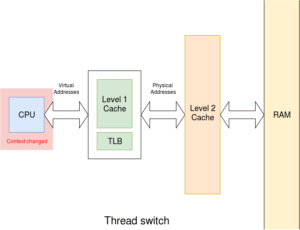Context Switching in Threads
In a multitasking environment, whether we’re dealing with processes or threads, the operating system often needs to switch from one execution unit to another. This mechanism is known as context switching. It is critical for enabling multiple threads to share CPU time efficiently, especially in concurrent or parallel systems.
Let’s explore what context switching is in the context of threads, how it works, and its significance in overall system performance.
What Is Context Switching?
Context switching is the process of saving the state of a currently running thread and restoring the state of the next thread that the CPU is about to execute.
Each thread has its own:
- Program counter (to know where to resume execution)
- Stack (to manage function calls and variables)
- Register set (to store temporary data)
When a context switch occurs, the OS must:
- Save the current thread’s state (its context)
- Load the next thread’s state
- Update scheduling data structures accordingly
This allows the CPU to pause and resume threads as needed, giving the illusion that multiple threads are running simultaneously (even if on a single-core processor).
Context Switching in Threads vs Processes
- Process context switching is heavier since it involves changing memory address space and more overhead.
- Thread context switching is lighter because threads within the same process share memory and resources. Only thread-specific data (stack, registers) needs to be switched.
That’s why multithreaded applications tend to be more efficient in high-frequency switching environments.
When Does Thread Context Switching Happen?
Context switching between threads can occur in several scenarios:
- Voluntary Yielding: A thread finishes or calls a function like
yield(), giving up the CPU.
- Blocking: A thread waits for I/O or a resource (e.g., file read or mutex lock).
- Preemption: In systems with preemptive scheduling, the OS forcibly switches threads after a time slice is used up.
- Priority Scheduling: A higher-priority thread becomes ready to run, so it replaces a lower-priority thread.
Cost and Impact of Thread Context Switching
Although thread context switches are faster than process switches, they are not free. Each switch requires CPU time to:
- Store and load thread states
- Update scheduler metadata
- Manage stack pointers and registers
This can impact performance in systems with:
- Too many threads (excessive switching)
- Frequent blocking or I/O operations
- Poorly designed synchronization leading to contention
Efficient scheduling and minimal context switching help preserve CPU efficiency and responsiveness.
Real-world Example
In a web server, multiple threads handle incoming client requests. If one thread is waiting for data from a database, the CPU can switch to another thread to keep processing new requests. This is made possible through fast and effective thread context switching.
Summary
Context switching in threads is a fundamental mechanism that enables multithreading and concurrency. It allows the CPU to juggle multiple threads by quickly saving and restoring thread states. While thread switches are faster than process switches, they still consume resources and must be managed wisely to maintain system performance.
